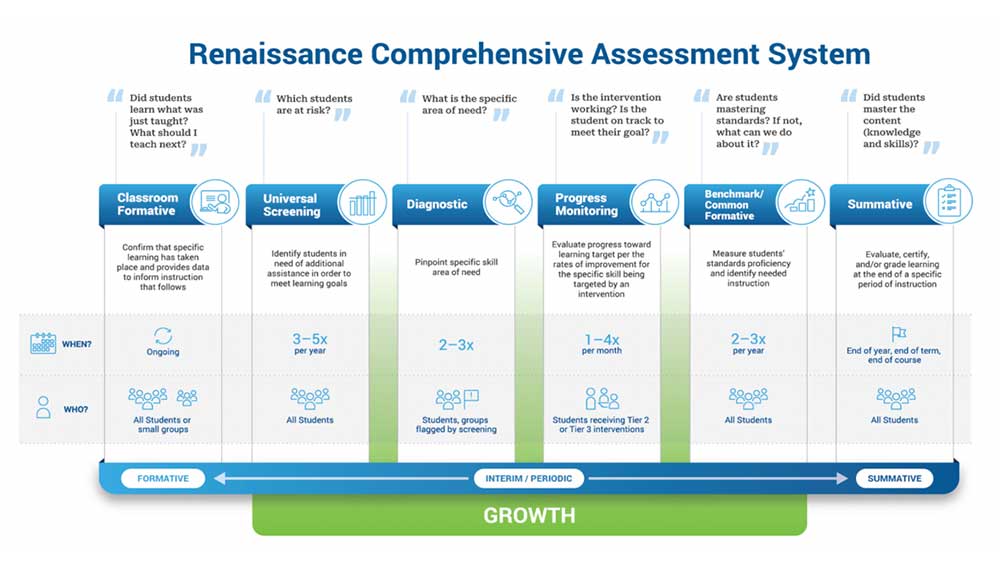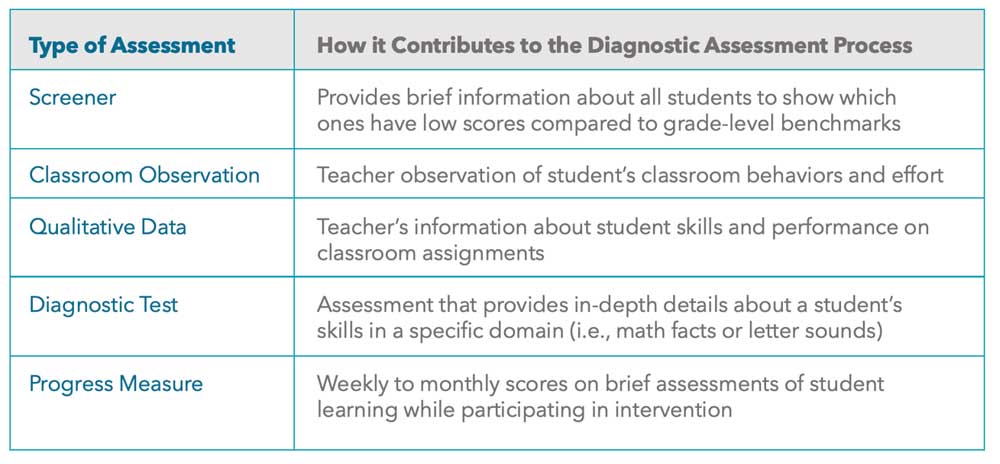February 27, 2023
Assessments come in all shapes and sizes and are a giant piece of the education puzzle. Understanding the multi-faceted nature of the many different types of assessments in education is essential to support both the teaching and learning processes.
If you want to develop a deeper understanding of educational assessments and how to implement different education assessment types more effectively in the classroom, you’re in the right place. In this blog, we’ll break down:
- A definition of assessment in education
- The 6 types of educational assessments
- How assessment tools from Renaissance can help simplify and enhance student assessment
How do you define assessment in education?
In the field of education, assessment refers to the varied methods and tools that are used to…
- Evaluate
- Certify
- Measure
- Monitor
- Observe
- Document
…the learning progress, academic readiness, skill acquisition, or educational needs of students. Assessment plays a key role in data-driven decision making and is an important part of the whole child data picture.
The different types of assessments enable us to answer key questions about student learning, such as:
- What do students know? What do they not know yet?
- Where are students struggling? Why?
- What should I teach next? What should I adjust in future lessons?
- Which students need an intervention? Which intervention matches the specific need?
- Does the retained learning meet district and state expectations?
- Does our curriculum have gaps between learning expectations and assessment?
But what are the common types of assessments in education? And what does each type of assessment help us understand about students’ learning and needs?
In this blog, we’ll take a look at each of the different types of assessment in education that come together to create a comprehensive assessment system. But first, let’s examine the “why” behind the types of educational assessments.
3 purposes for assessment in education
In general, assessment in the classroom serves one of three purposes:
Assessment of learning: These assessments help us to identify if students are meeting grade-level standards. They’re usually grade-based and have a concrete grade attached to them that communicates the level of achievement.
Assessments of learning might include:
- Exams
- Portfolios
- Standardized tests
- Final projects
Some other common forms of assessment of learning include:
- Criterion-referenced assessments
- Norm-referenced assessments
- Summative assessments
Assessment for learning: These assessments provide educators with a clear picture of student learning and understanding as they teach. They’re then able to make the necessary adjustments to their classroom management strategies, lesson plans, etc., as they go.
Assessments for learning must be ongoing and actionable to effectively provide teachers with in-the-moment feedback to improve their instructional methods.
Some common types of assessment for learning include:
- Diagnostic assessments
- Formative assessments
Assessment as learning: This type of assessment in education actively involves the students in the learning process. It teaches them to access their critical thinking and problem-solving skills, along with how to set achievable personal goals to objectively measure their own progress.
Assessment as learning is a helpful way to engage students in the learning process and help them take ownership of their learning.
Examples of assessment as learning include:
- Self-assessments
- Peer assessments
Why is it important to understand types of assessment in education?
Assessments help us to answer key questions about student learning and what to teach next. But in order for assessment data to help drive decisions, it is imperative that we use an assessment tool that is appropriate to the task at hand. Understanding the types of assessments is the first step to using assessment data to effectively support the needs of students.
For example, progress monitoring assessments are extremely sensitive to growth and are designed to measure small, incremental increases in progress. Other types of assessments aren’t structurally designed to measure those small increases in growth. Using an interim assessment weekly or bi-weekly will not help educators accurately track student progress—and may even lead to confusing or misleading results.
Without a sound understanding of the different types of educational assessments and their purposes, it’s easy to use an assessment for a mismatched task. For that reason, it’s important that all educators have a foundational understanding of the types of assessments and what each assessment type can and cannot tell us about student learning.
To learn more about types of assessments and how to build a comprehensive assessment system that meets your unique needs, download our Complete Guide to Comprehensive Assessment Systems eBook.

What are the main methods of assessment?
Although nomenclature can vary from district to district, there are six main types of assessments in education:
- Classroom formative assessments (just-in-time/short-cycle)
- Universal screening assessments
- Diagnostic assessments
- Progress monitoring assessments
- Benchmark/common formative (interim assessments)
- Summative assessments
6 different types of assessment in education
In the sections below, we’ll explore how each of these types of educational assessments helps you to analyze and support student learning.
#1: Classroom formative (just-in-time/short-cycle assessments)
Classroom formative is a process used by teachers and students during instruction. It creates feedback and reveals any needed adjustments for ongoing teaching and learning that may be necessary to increase students’ achievement of the intended instructional outcomes. Classroom formative assessments are used as tools to inform and fuel the formative assessment process on an ongoing, frequent (even daily) basis.
When used formatively, assessments can overcome some traditional, commonly-conceived limitations of “tests.” With the right tools in place, such as DnA’s Live Proctoring Tool, short-cycle assessments can be spun up quickly and adapted to meet immediate student needs as necessary during the learning process. Using these just-in-time assessments can yield a plethora of rich information to feed instructional processes and deepen students’ metacognitive processes.
Some examples of formative just-in-time/short-cycle assessments include:
- Classroom assessments
- Quick quizzes
- Discussion
- Observations
- Comprehension checks
- Entrance/exit tickets
Keep in mind that any assessment can be a part of the classroom formative process as long as it’s used to provide data to inform instruction.
Assessments to drive student learning
Discover high-quality assessments from Renaissance for pre-K–grade 12 learners.
#2: Universal screening assessments
Universal screening is the process of gathering academic and social-emotional behavior (SEB) data about all the students in a class, grade, school, or district in order to identify which students need additional assistance to meet learning goals.
Universal screening assessments are administered as tools to inform and fuel that process. They’re most often administered to all students in the areas of reading, math, and SEB. Screening happens early in the school year and may also occur at other points throughout the year.
Universal screening assessments should be valid, reliable, and have a high degree of predictive validity with high-stakes tests. These types of assessments are critical to an effective multi-tiered system of support (MTSS) implementation, as they identify Tier 1 needs as well as students who may be at risk and in need of additional support.
Some examples of K–12 universal screeners from Renaissance include:
- Star Reading in English and Spanish
- Star Math in English and Spanish
- FastBridge in Reading, Math and Social-Emotional Behavior
#3: Diagnostic assessments
Diagnostic assessment is the process of using multiple measures and reports to identify what a student does or does not know in relation to specific learning goals in order to guide academic, curricular, and instructional decisions.
Diagnostic assessments can be administered as tools to inform and fuel that process. They’re often administered to students, grade levels, and/or groups flagged by universal screening to pinpoint specific learning needs (e.g., calculation vs. math).
High-quality universal screeners provide diagnostic reporting as part of the universal screening results. And tools like the Star Phonics assessment for K–6 students complement universal screening data by providing in-depth critical insights into students’ acquisition of essential phonics skills.
Diagnostic assessment is critical to MTSS implementations, as it helps ensure interventions are appropriately aligned to students’ specific needs. These data should be used in conjunction with other data—as part of an evaluation of a student’s academic and SEB learning needs—before reaching diagnostic conclusions about student performance.
Types of assessment often used in the diagnostic assessment process:

#4 Progress monitoring assessments
Progress monitoring is a standardized process of evaluating progress toward a performance target, based on rates of improvement from frequent (usually weekly) assessments of a specific skill. Progress monitoring assessments are administered as a tool to inform and fuel that process. They’re typically administered to all students receiving Tier 2 or Tier 3 interventions.
Progress monitoring assessments are very sensitive to growth and are aligned with the skill or need that is targeted by a specific intervention. They help measure whether the intervention is working and if it’s working fast enough.
Examples of progress monitoring assessments include:
- FastBridge
- Star Assessments
- Running records
- Mastery measurement
- Curriculum-based measurement
- Direct behavior ratings
#5: Benchmark/common formative (interim) assessments
Benchmark assessments, which are sometimes referred to as common formative assessment or interim assessment, measure students’ standards of proficiency. They’re typically administered periodically or seasonally (e.g., fall, winter, and spring).
These assessments are aligned to a pacing calendar and the district’s scope and sequence—or the progressive order in which students encounter the content that they’re expected to master by the end of a course, study, or curriculum.
Benchmark/common formative assessments are often used to predict the students’ end-of-year proficiency. They are usually created either by a professional assessment vendor or by using a valid and reliable item bank in order to ensure quality.
Renaissance’s Star Math is one example of interim assessment. This award-winning assessment solution helps educators:
- Quickly screen students
- Monitor progress
- Track growth over time
- Forecast future performance on state summative assessments
With Quantile® measures—which measure the difficulty of mathematical skills and concepts as well as a student’s readiness to learn new skills and concepts—Star Math provides educators with additional insights into students’ math progress.
#6: Summative assessments
Summative assessment is the process of evaluating or certifying learning at the end of a specific period of instruction. Summative assessments are often used for grading students and can be used to measure growth or changes in student learning. They’re typically administered at the end of year, end of course, or end of term.
Summative assessments in education can provide a host of useful data regarding student achievement, while also guiding decision-making around changes in curriculum, instructional strategies, staffing ratios, course offerings, and professional development needs.
Just as formative assessment is a process, so is summative assessment. Any assessment can be part of the summative assessment process if it’s used to evaluate or certify learning after instruction has occurred. Many teachers employ unit exams and Friday spelling tests, for example, as summative assessments.
Additional examples of summative assessments include:
- High-stakes state standards assessments
- SAT
- ACT
Guide instruction & improve learning outcomes with Renaissance’s comprehensive assessment solution
Renaissance equips educators to take a data-driven approach to serve the whole child with our Comprehensive Assessment Solution. This comprehensive assessment system combines MTSS management and collaboration, and real-time dashboard tools, and puts them in the hands of educators.
As a result, educators can…
- Monitor learning and growth
- Identify academic and social-emotional behavioral needs; and
- Align targeted supports
…to accelerate learning for each student.
Our complete set of standards and skills-based assessment tools give educators the confidence they need to understand each student’s academic and social-emotional behavior (SEB) learning and needs and guide instruction to improve student outcomes.

